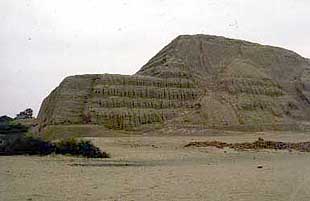|
The Moche culture reigned on the north coast of Peru in the years 100-700 A.D. Its relics have been found from thirteen river valleys in about 400 kilometres long land area. Several ideologically and artistically similar states were reckoned among the culture. Exclusive of the states in the southern Moche river valley, they did not constitute a larger federation at any stage. Warrior priests that exercised temporal and religious power ruled the Moche society. The tomb of the Lord of Sipán on the ground floor of the museum is the last resting place of one such man of power.
The long duration of the Moche culture has been divided into five stages mainly on the basis of ceramics. In the early stage (the periods I and II of ceramics), the essential features of the culture were slowly moulded mainly on the basis of the Gallinazo culture. The middle stage which is dated to the years 300-600 A.D. and which includes the periods III and IV of ceramics, is regarded as the golden era of the Moche culture. The last stage of the culture started at the end of the 6th century. The dying down of the Moche culture was a result of many different reasons. At least climatic catastrophes, pressure from the expanding Wari state and internal tensions of the society furthered the process.
Ceramics was undoubtedly the most central of art forms. Also, metallurgy flourished during
the era of the Moche culture. It was known how to cast, solder and alloy metal. The joining of different metals as part of the same artefact was mastered, and, in the same way, the gold-plating of copper artefacts. A considerable part of the status artefacts of the Moche elite was made of metal.

The Pyramid of the Sun, situated in the Moche river valley, is badly destroyed, but it was in its time the biggest adobe structure of the whole ancient Peru.
© Martti Pärssinen
|
The Moche Ceramics
Ceramics is the most significant art form of the Moche culture, and its world of motifs is larger than that of any other ancient Peruvian culture. The Moche ceramists created both sculptural and plain paint-ornamented vessels. The most popular vessel form was the traditional stirrup spout vessel. All vessels were made with the help of a mould.
Animals and plants of the coast and scenes of human life and mythology were the decorative motifs of the Moche ceramics. Despite the individual way of depiction, the grandest Moche ceramics was not art for art´s sake, but it helped to justify and reinforce the ideology of the Moche culture and the power of its aristocracy. The scenes of the paint-decorated ceramics are easily interpreted as ceremonial in nature even today, but the scuptural works have probably also been part of this mythology of the Moche culture.
The ideological-religious basis of many a prehistoric culture has been forgotten after the dying down of the culture.
However, the ceramic pictures together with archaeological materials have made a partial reconstruction of the Moche mythology possible. The most important of the religious rituals of the Moche culture was apparently the sacrificial ceremony, in which prisoners of ritual war were sacrificed to gods. Other central scenes of the Moche ceramics are, among other things, funerals of high-ranking persons, hunting of elks and sea lions plus fights between human and supernatural beings.

Sculptural ceramics was one of the trademarks of the Moche culture. Portrait vessels like this depict either real elite persons or figures from the Moche
mythology. © Museo Arqueológico Rafael Larco Herrera, Lima, Peru (Cat. 94)

The most magnificent vessels were decorated in a great detail. This vessel depicts a scene between two mythological
persons. © Museo Arqueológico Rafael Larco Herrera, Lima, Peru (Cat. 105)
|

